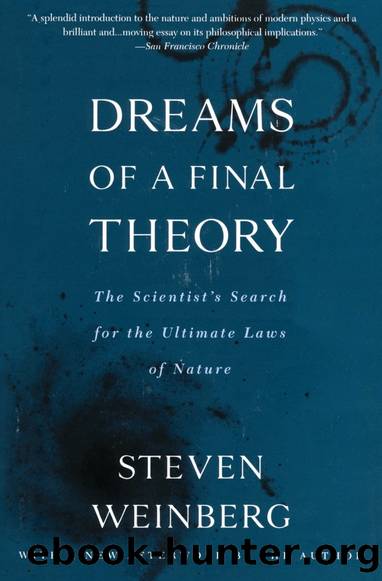Dreams of a Final Theory: The Scientist's Search for the Ultimate Laws of Nature by Steven Weinberg

Author:Steven Weinberg [Weinberg, Steven]
Language: eng
Format: epub
ISBN: 9780307787866
Google: QfmqHHYWiK4C
Barnesnoble:
Goodreads: 11072883
Publisher: Knopf Doubleday Publishing Group
Published: 2011-04-20T05:00:00+00:00
* E.g., the frequency with which the wave function of any system in a state of definite energy oscillates is given by the energy divided by a constant of nature known as Planckâs constant. This system appears much the same to two observerswho have set their watches differently by one second, but, if they both observe the system when the hands on their watches both point precisely to twelve noon, they observe that the oscillation is at a different phase; because their watches are set differently they are really observing the system at different times, so that one observer may, e.g., see a crest in the wave, while the other sees a trough. Specifically, the phase is different by the number of cycles (or parts of cycles) that occur in one second; in other words, by the frequency of the oscillation in cycles per second, and hence by the energy divided by Planckâs constant. In todayâs quantum mechanics, we define the energy of any system as the change in phase (in cycles or parts of cycles) of the wave function of the system at a given clock time when we shift the way our clocks are set by one second. Planckâs constant gets into the act only because energy is historically measured in units like calories or kilowatt hours or electron volts that were adopted before the advent of quantum mechanics; Planckâs constant simply provides the conversion factor between these older systems of units and the natural quantum-mechanical unit of energy, which is cycles per second. It can be shown that energy defined in this way has all the properties that we normally associate with energy, including its conservation; indeed, the invariance of the laws of nature under the symmetry transformation of resetting our watches is why there is such a thing as energy. In much the same way, the component of the momentum of any system in any particular direction is defined as the change of phase of the wave function when we shift the point from which positions are measured by one centimeter in that direction, again times Planckâs constant. The amount of spin of a system around any axis is defined as the change of the phase of the wave function when we rotate the frame of reference we use for measuring directions around that axis by one full turn, times Planckâs constant. From this point of view, momentum and spin are what they are because of the symmetry of the laws of nature under changes in the frame of reference that we use to measure positions or directions in space. (In listing the properties of electrons I do not include position, because position and momentum are complementary properties; we can describe the state of an electron in terms of its position or its momentum but not both together.)
* What I call âsmoothâ phase transitions are also often called second-order phase transitions.â This is to distinguish them from âfirst-order phase transitions,â like the boiling of water at
Download
This site does not store any files on its server. We only index and link to content provided by other sites. Please contact the content providers to delete copyright contents if any and email us, we'll remove relevant links or contents immediately.
| Aeronautics & Astronautics | Astronomy |
| Astrophysics & Space Science | Comets, Meteors & Asteroids |
| Cosmology | Mars |
| Solar System | Star-Gazing |
| Telescopes | UFOs |
Tools of Titans by Timothy Ferriss(8219)
Turbulence by E. J. Noyes(7937)
Secrets of Antigravity Propulsion: Tesla, UFOs, and Classified Aerospace Technology by Ph.D. Paul A. Laviolette(5309)
Astrophysics for People in a Hurry by Neil DeGrasse Tyson(5134)
Room 212 by Kate Stewart(5040)
Design of Trajectory Optimization Approach for Space Maneuver Vehicle Skip Entry Problems by Runqi Chai & Al Savvaris & Antonios Tsourdos & Senchun Chai(5011)
Pale Blue Dot by Carl Sagan(4913)
The David Icke Guide to the Global Conspiracy (and how to end it) by David Icke(4628)
A Journey Through Divination and Astronomy by Publishing Pottermore(4344)
Goodbye Paradise(3728)
Apollo 8 by Jeffrey Kluger(3637)
COSMOS by Carl Sagan(3554)
Losing the Nobel Prize by Brian Keating(3499)
The Five People You Meet in Heaven by Mitch Albom(3476)
How to Read Water: Clues and Patterns from Puddles to the Sea (Natural Navigation) by Tristan Gooley(3409)
Brief Answers to the Big Questions by Stephen Hawking(3369)
How to Read Nature by Tristan Gooley(3249)
The Order of Time by Carlo Rovelli(3145)
A Brief History of Time by Stephen Hawking(2962)
